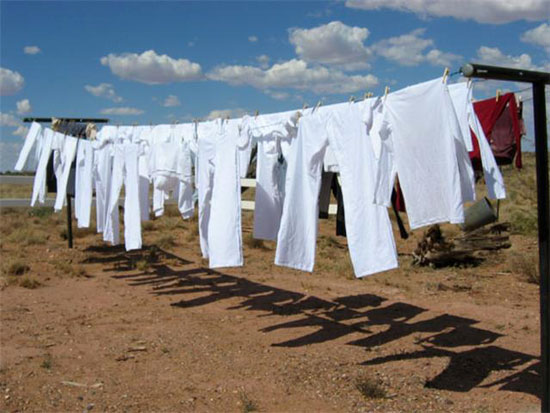
Some of you know that one of my biggest challenges due to environmental illness (EI) has been finding tolerable clothing. Many people with chemical sensitivities have great difficulty getting new clothes tolerable due to all the chemicals and dyes used in modern clothing manufacturing processes. Even organic cotton, wool, linen, bamboo, and hemp materials can cause problems for many with chemical intolerances, because we can become sensitized to the natural plant oils. To add to the problem, many of us do not tolerate laundry detergents and cannot clean our clothes even if we are able to get them tolerable enough to wear.
Around two years ago after a pesticide exposure in Florida, my challenges with clothing became insurmountable and I found myself sitting naked in my apartment for a week. I wrapped myself in an old shawl to do laundry outside and was able to get one outfit tolerable enough so that I could attend a week at the Hippocrates Health Institute. I spent 5 days drinking vitamin and mineral rich green vegetable juices and eating salad. The nutritional infusion was enough to boost my health so that I could drive across country to Arizona in search of safe housing. I made the 4-day trip wearing my bathing suit and shawl!
What I have been forced to wear due to my severe intolerance of standard clothing materials. The shirt on the left was turned upside down and used as pants when I no longer tolerated any of my sweatpants or leggings last winter. I tied the arms up as they shredded from use, to create a “socks” effect. What you can’t see is that it is riddled with small holes and is quite thin. The underwear is ridiculous but I needed something to use during my menstrual cycle to hold my sanitary napkin in place. I’m not proud to display these, but I think it is important to raise awareness at how desperate the situation is for some of us.
After I arrived in Arizona, I was unable to wear any of the clothes I had brought with me. A local friend donated several shirts and pairs of pants to me that I was able to wear because she had spent a long time washing and offgassing them. I wore those clothes for 2 years straight without ever washing them, until they literally fell off my body in shreds. Lucky for me, by this time I had discovered a procedure for washing my clothes that worked! It’s laborious and my electric bill is suffering greatly, but I finally have some clothes to wear.
Here’s what I do:
• When I receive new clothes in the mail, I turn them inside out (to avoid discoloration and fading from sun exposure) and place them outside on the clothesline for several days or even weeks, making sure to bring them inside before it rains or if there are heavy airborne exposures like controlled burns or fabric softener fumes from neighbors.
• Then I boil like clothes (all organic, or all whites, etc.) in a stainless steel stockpot on a commercial hotplate outside my home for about 5 hours. Do not attempt to boil clothes indoors, as all the toxic chemicals and/or plant oils will be released into your safe home environment. I use a drop of Allen’s Naturally detergent which I do not necessarily tolerate, but it rinses out completely. I also add several handfuls of sea salt once the water is boiling. Be careful, as the sea salt can discolor and stain your clothing – best to push the clothes aside with a stainless steel tong as you dump the salt in and swirl it around so that it dissolves and does not sit in a clump on your clothes.
• I then wash the boiled clothes in my washing machine with Allen’s Naturally detergent for one full wash cycle with an extra rinse, then send through the wash and extra rinse cycle again, but this time without any detergent – just water. I do this to make sure all the Allen’s detergent is rinsed out of my clothing. You can use whatever detergent you tolerate. Some people prefer organic soap nuts rather than a detergent. Depending on your sensitivities, you may not need to rinse them as well as I do, or you might require more of a rinse.
• I air dry them overnight on my beloved stainless steel collapsible drying rack. Personally, I have found I tolerate my clothes better when I dry them inside my home rather than in the outdoor air, which can contaminate them with pollutants like wood smoke, neighbors’ laundry products, or even local plant fragrances. You might experiment to see what works best for you.
• I usually cannot tolerate my clothing after this first cycle of boiling and washing, so I then have to repeat the whole process, but this time boiling only 1-3 hours. This process has enabled me to get several shirts and pants tolerable, as well as a light blanket. I can even now tolerate some organic cotton pieces, which I could not before.
I’m not sure why the sea salt is necessary, but two people with severe reactivity to fabrics recommended it to me. If I had to guess, I would say it helps draw out the chemicals, and kills any bad bacteria. I have also wondered if it affects the electrostatic qualities of the clothing because one of the people who recommended it was severely EMF sensitive like myself. If anyone knows why sea salt helps the process, please let me know in the comments section below.
Here are links to all the resources I use. You might find better prices or slightly different products that will give you similar results:
Nemco Single Burner Stainless Steel Commercial Hotplate – 2000 watts, 240 volt (this link is to the double burner; call the company and ask for the single burner unit) <$200 (plus shipping) from Katom Restaurant Supply Stainless steel stockpots – purchase pots as large as your hotplate can handle so you can fit ample pieces of clothing in them.
Allen’s Naturally Biodegradable Liquid Laundry Detergent <$12 from NEEDs Celtic Sea Salt – 5 lb bag $22.50 + shipping from Selina Naturally
240 volt outlet box – I paid ~$50 to have a special outlet installed by a local electrician outside my home near my electric panel; your price might vary depending on how far the electrician has to travel. Make sure the outlet fits your plug, as 240 volts can have different configurations.
Drying Rack – I purchased my stainless steel drying rack from Stacks and Stacks many years ago. They don’t seem to make it anymore but there are similar styles available on Amazon.com. I chose a more expensive stainless steel version rather than wood to avoid mold and warping.
These are the clothes that have worked for me so far:
American Apparel – supposedly clothing made by this company does not have the toxic sizing/finishes that clothing made in China does, and it’s made in the US which greatly reduces the chance that it’s been sprayed with insecticide. Plus, I’ve been told that they use cotton piping in their cotton pieces instead of polyester serging. I have had luck with their non-organic cotton, but they also do sell some organic pieces.
#RSA6321 Sheer Jersey Long Sleeve Henley Dress – 100% sheer jersey cotton
#6307 Sheer Jersey Long Sleeve T – 100% sheer jersey cotton
#5450 California Fleece Slim Fit Pant – 100% cotton (except for Heather Grey)
#5375 California Fleece Straight Leg Pant – 100% cotton (except for Heather Grey)
#8375 Cotton Spandex Jersey Straight Leg Yoga Pant – 95% Cotton / 5% Elastane (Heather Grey contains 10% Polyester)
Patagonia – Women’s Serenity Tights 85% organic cotton/15% spandex knit
Hanes – Men’s Boxer Briefs They no longer carry this item but you might have luck with other 100% cotton styles. My first pair was donated by a neighbor, and since I tolerated them I kept buying them. They might also sell women’s underwear that works for you. Keep in mind that sometimes the materials used changes so you should look carefully at those listed on the website before ordering.
Jockey – Seamless Cotton No Wire Bra
These clothing items and this washing process might not work for everyone. And there may be other less expensive and laborious ways of washing clothes that are better suited for you. This is what worked for me and I am sharing it with the hopes it can help someone else who is stuck without clothing or with clothing that is dirty and tattered.
Below are some soaking techniques others have shared with me over the years. Make sure you have a tolerable tub or basin to soak your clothing in. I use stainless steel warming trays I bought from a restaurant supply store.
Baking soda or borax soak
Soak laundry in a baking soda or borax bath overnight using about 1 cup of product per load to remove odors. Follow with your favorite well-tolerated detergent. Rinse well. If using a machine, send through the rinse cycle twice.
Milk soak
The fat in milk is said to absorb chemicals. Immerse your laundry in whole milk and place in a covered pot in the refrigerator to avoid souring the milk. Let it sit for 24 to 48 hours and then rinse well. Follow with a baking soda or vinegar bath to remove the milk smell from laundry. Follow that with your favorite well-tolerated detergent. Rinse well. Many have used powdered milk with good results.
Vinegar soak
Soak laundry in a distilled white vinegar bath overnight to remove odors. Use about 1 cup vinegar per load. Make sure you use a grain-based vinegar – Heinz used to be grain-based but may now use a GMO corn-base. Follow the vinegar bath with baking soda to remove the smell if you wish, and then your favorite well-tolerated detergent. Rinse well. If using a machine, send through the rinse cycle twice.
Tolerable detergent soak
Some people have luck soaking clothing for two weeks or even a month in a tolerable detergent, changing the water if it gets mold or too stinky.
Sun soak
Combine any of the other soaks with some natural solar heat: after washing, dry your clothes outdoors if you have access to clean air and the hot sun. The sun’s rays can bake odors (and mold!) out of clothing. You may have to leave your laundry outdoors two weeks, or longer. Make sure there are no fabric softeners, burning wood, pesticide sprayings or other harmful toxins in the air from neighbors; they could re-contaminate your clothing.
Plain water wash
Not recommended. I used to wash my clothes in plain water and then at one point could not tolerate any of them. Others suggested that the water alone cannot remove body oils, candida, offgassing chemicals, etc. and that I needed to use a detergent if I wanted to keep my clothes clean.
What if you have to use a public laundromat?
When I first became chemically sensitive, I was using public laundromats in New York City – can you imagine!? I don’t recommend it!! There are some of you who must use a public laundromat, and here are my tips for how to minimize exposures and clothes contamination there:
• Wash your clothes during off hours when the least amount of people are using the laundromat – ask the owners for the best times. The earlier the better, before the machines have built up chemicals from being used all day.
• Run one or more cycles with a tolerable vinegar (and no clothing) to clean the machine out as best as possible before putting your clothing in.
• When transferring your wet clothes from washer to dryer, put them in a plastic bag and transfer them as quickly as possible to avoid contamination with whatever chemicals are airborne. I contaminated an entire wardrobe by not following this advice.
• Or, avoid the dryer altogether and bring your clothes home to hang dry immediately. If fabric softener has been used in a dryer, there will always residue that can potentially contaminate all your clothing. The chance of this is pretty high in a public laundromat.
Tools for handwashing clothes
If you live in a city your best option may be to handwash your clothing, since many landlords will not allow washing machines to be hooked up in rental units. Here are some resources for making the process easier. I cannot vouch as to whether or not they would be tolerable for people with environmental sensitivities. Please do your due diligence and research materials before buying any product:
Galvanized Wash Tubs
Lehman’s Own Washboards
Rapid Washer
Galvanized Double Rinse Tubs
Lehman’s Hand Washer
WonderWash Mini Clothes Washer
Lehman’s Best Hand Wringer
Dyna Jet Hand Wringer
I would also like to add, that water quality is a big issue to figure out if you are challenged by clothing. When troubleshooting, keep in mind that sometimes the water you are washing the clothes in is actually the culprit. Please see these links for more on water purity: Pure Air and Water | Water Filters | Dr. William J. Rea on Best Water Source. If you are chemically sensitive and have additional tools, products, or techniques for washing clothing that you’d like to share, please post them in the comments section below.


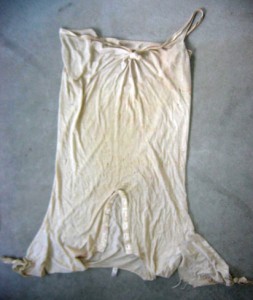
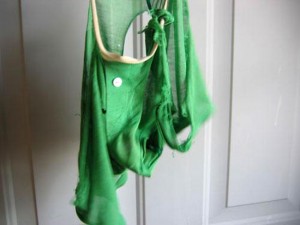
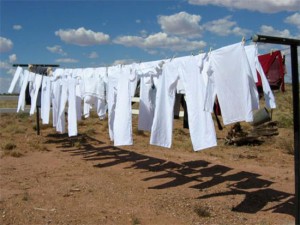
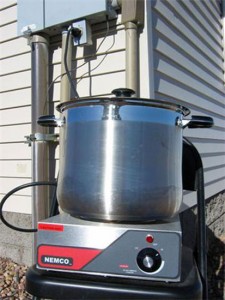
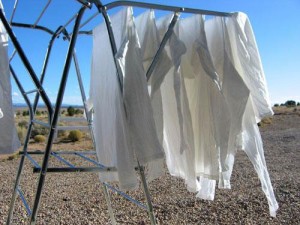
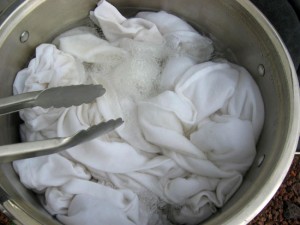

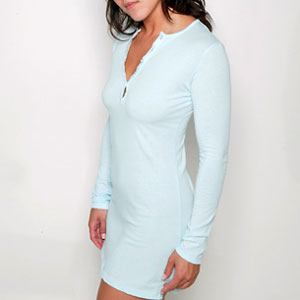









Hi Karen,
I would usually put the lid on in the beginning to help bring the water to a boil. Once it started to boil, I would remove the cover. My thought process was that I did not want any chemicals being released in the fumes to get reabsorbed into the clothing through the water. I don’t know if that would happen, but it did cross my mind so I decided to keep the cover off while boiling. Best, Julie
I have read several excellent stuff here. Certainly worth bookmarking for revisiting.
I wonder how a lot attempt you put to make this type of great informative website.
You had a question about why the sea salts work… I do natural plant dyeing – salt is a fixative. Also salt is antiseptic. That’s part of why salt rinses are popular after dental work. I hope that helps.
What if people who are intolerant to chemicals,break down chemicals at a slower speed than healthy people,possibly due to liver damage that cannot be diagnosed through blood tests?It seems to be an impossible task to persuade researchers to look into this possibility even though it is totally logical and supported by information in medical journals.Does anyone have any advice regarding who i should contact about this?
Hi Connie,
I had always been told that people with environmental illness usually have impaired liver detoxification pathways. I think this is well accepted by MCS researchers like Dr. William Rea and Martin Pall, PhD. Not sure which researchers you are wanting to contact.
There is a theory that the liver detox pathways are impaired because the limbic system has been damaged by a toxic exposure, causing it to get stuck in emergency mode and down-regulating all the body systems including the immune and detoxification systems. Once you normalize the limbic function, then it is said that the detox and other systems will then also be normalized.
Many people are having success with brain retraining programs and tapping modalities like EFT and FasterEFT to overcome fabric sensitivities and other reactions (see http://limbicretraining.com/ for more info on these approaches). I am one of them.
It’s been great not to have to boil my clothes anymore! I only need to wash new clothes once or twice in my machine now. I can wear a lot more clothing, and even tolerate some bedding now. It’s such a relief not to go through such an arduous process to get clothing now. I worked long and hard with brain retraining and EFT – it was not an overnight process. It took a lot of hard work and commitment. And I am still a work in progress….trying to increase my wardrobe even more now and get more bedding and a real mattress.
I got into big trouble with this boiling method. I was having a sensitivity to underwear boiled them then I put them dripping wet into the washer. I didn’t rinse the washer before washing other clothes. I didn’t realize I would have a problem and did the boil numerous times. Now it’s in my pants and towels ect. and I can’t get out whatever was bothering me I’ve ruined numerous items. The underwear are still unwearable. I wish I never heard of the boiling method.
Hi Karen,
I am so sorry to hear this. I really recommend line drying all boiled clothing outside and smelling before putting in your washer. Do not put in your washer if it still smells toxic to you and/or causes a reaction. Not sure if your underwear is organic or not, but boiling can potentially create a more toxic situation if you are boiling chemicals.
I had a similar situation with organic corduroy pants. I boiled them and dried them… and they smelled really toxic. I still chose to put them in my washer, which I then felt was “contaminated” by doing so. I was heartbroken.
I am happy to share that through cleaning out the washer with my tolerated detergent (I use Allen’s Naturally) as well as diluted Seventh Generation non-chlorine bleach (hydrogen peroxide) over and over and doing brain retraining, I was eventually able to use my washer again AND I could even wear the corduroy pants.
If you haven’t heard about brain retraining, I highly recommend you check out http://limbicretraining.com to find out more. Don’t give up! You will get past this. I’m so sorry it happened but yes, there is always that possibility if you put something that is still “toxic” to you in your washing machine. This boiling method is not a guarantee that you will tolerate the clothing after boiling your clothes. It’s just one tool that I and others have had success with, but sometimes it takes boiling repeatedly and washing repeatedly to reach that success. It is a laborious process and it comes with risk if you are putting your clothes into your washing machine. Anything you put in your washing machine, whether boiled or not, has the potential to “contaminate” it.
I no longer have to boil my clothes or spend countless hours washing over and over. I can just wash once or twice in my washer after I buy them and wear. I only buy organic clothing though. I am able to do this because of brain retraining and EFT and FasterEFT. I have used those modalities for the past several years and had some success. You can read more about my process and success with these methods here: http://limbicretraining.com/contributors/my-recovery-from-severe-fabric-sensitivity
Please let us know how this all turned out. I know you can get your washing machine tolerable again in time, and wear the new underwear. Don’t give up!
Earthwalker thank- you so much for responding. I can’t use my washer at all and most everything I own has been washed and contaminated. I did the multiple boiling method to numuous amounts of underwear and didn’t wash out my washing machine afterwards and no the clothes were not organic. I will try to de contaminate my washer using the hydrogen peroxide. Can I us non scented oxy clean because I don’t tolerate fragrance? Thank- you again for the encouragement as I do feel hopeless sometimes. I will look into EFT…will it still work if it’s truly a severe sensitivity?
Also how did you de contaminated the corduroy pants to be able to wear them?
Hi Karen,
I would try using anything that YOU tolerate. If you tolerate any vinegar, or borax, or baking soda, try those things. I did not tolerate those things so all I could try is the hydrogen peroxide. And give it time. Just because you don’t tolerate it today, don’t think it is ruined forever. You’ll get there. You asked how I decontaminated the corduroy pants. Well, I didn’t. I just changed my response to them using brain retraining and EFT. You can, too. Yes, it works for severe sensitivities. I consider myself pretty severe. Clothing and bedding are huge issues for me. But I worked very hard to do the brain retraining and EFT – and I worked with coaches when I could not motivate myself. I highly recommend either the Gupta or Hopper program AND FasterEFT. Let me know how it turns out. So sorry to hear you washed all your clothes in it. I do believe you can turn this around using brain retraining, EFT, and continuing to wash out your machine. Let me know how it goes over the next few weeks. xx
I would like to share that for those who are washing by hand and can tolerate plastic buckets you can make a simple inexpensive press for removing exess water from clothes by drilling many holes in a sturdy 10l bucket that has a rim wide enough to fit over a 20l (5gallon) bucket. Sit the holey bucket on the big one, place in the wet clothes, and then you can either kneel on the wet clothes or better still, add another 10l bucket on top and sit on the lot. this removes a comparable quantity of water to hand wringing but it is quicker and eaiser on the hands and forearms. All the best to you all.
I noticed in the older comments, a few questions about clothes that have been washed with fragranced detergence. I personally have had good sucsess with repeated washing of these type clothes that have been given to me. Best of all is lots of sunshine (hot if possible). I find these items are wearable much sooner than new clothes. Not all second had clothes are suitable. If it has the slightest hint of mothballs, avoid at all costs.
I’d love to hear follow up on whether Karen was able to decontaminate washer and/or tolerate after EFT, etc.
This will be like my 8th time – literally – contaminating a washer. Much harder to keep things safe with a family. I’d love any tips and will continue with tapping, etc. But I worry it’s typically mycotoxins and for that, I’ve never found anything that worked. Clothes, sheets, washer, all “bad” now. Feeling really depressed b/c not the first time but I’d been doing so well for two years – no laundry incidents :(
I’m becoming more and more sensitive to new clothing. First it was just spandex-containing clothing (for about 9 years). Now it is many 100% cotton items, some acrylic items, and modal items in addition to spandex items. Are the manufacturers making these fabrics out of new worse chemicals, or why do you think I can wear old clothes containing spandex for example, but not new ones?
I soak my clothes with just plan water in a pot for as long as a month. I have pretty clean well water. The type of water you use and the pot you use is important. I have found I only soak the clothes in stainless steal or glass pots. I change the water occasionally. The clothes do get a little musty. For me the musty smell goes away after I wash and dry them. I would try it out on something not important to you in case the mold is a problem for you. I also only soak one thing at a time so i don’t cross contaminate clothes, especially if they are different brands, stores, etc. I have soaked 2 different items together before and made the situation worse.
Response to Donna and spandex: I have read they have changed the way the manufacture spandex. it is much cheap to produce now so I am guess it is different chemically.
Brands of clothes that I find more tolerable:
Levi jeans in 100% cotton, try mens or boys jeans they tend to be less chemically especially if they are not faded, distressed etc. The old fashion jeans like 30 years ago.
Faded Glory brand by Walmart, I have done well with their stuff as long as it’s 100% cotton
For those who must use a public laundromat, try pre-washing the washing machine with Bio-Kleen Fruit Wash. Put about 6TBSP into jug filled with HOT water and then pour it into the detergent/softener reservoirs. Run the machine on a full hot wash. Follow up in one of the later rinses with undiluted White Vinegar. Bag clothes that won’t go into dryer immediately and remove from laundromat.
For the dryer, I try to sniff out least smelly machine. I wipe out the entire interior as best as I can with undiluted White Vinegar. Bag clothes as soon as they’re done and remove them from the Laundromat.
Best to go to laundromat during it’s least busy time.
I kind of cringed when I saw “borax” mentioned because I am extremely allergic to borax (sodium borate)! It is a known irritant.
What do people fined is the best new washer and dryer to buy if one has chemical sensitivities? Please say the brand and if its a top load washing machine or front loader. Thanks for sharing this information with everyone.
I had MCS symptoms when young, but delt with Lyme Disease that went undiagnosed for 15yrs and then was exposed to black mold for 6yrs on top of that. The experience was unimaginable.
Once removed from toxic environment and health management with Lyme my immune system slowly recovered. Still had trouble with bedding and clothing.
I found the boiling technique worked if I added Sodium Carbonate (arm & hammer washing soda) and heated for 1hr minimum. It worked with store bought clothes 90% of the time. Not so much with wrinkle free products.
Also sleeping bags and traditional Turkish blankets were the only solution for bedding.
Goodluck All, Dont Give Up…